Most visitors to Sydney have a travel list that includes the Sydney Opera House, Sydney Harbour Bridge, and points in between. If you fall into this category, my suggested self-guided walking tour Sydney (with a few short ferry and train rides) includes 25 magical points of interest.
Table of Contents
- A few tips
- Self-guided walking tour Sydney
- 1. Soak up the view from Platform 2, Circular Quay
- 2. Drop into the Museum of Contemporary Art Australia (MCA)
- 3. Squeeze through Suez Canal
- 4. Explore Nurses Walk
- 5. Admire Cadmans Cottage
- 6. Wander around the Overseas Passenger Terminal
- 7. Explore Hickson Road Reserve and Dawes Point-Tar-Ra
- 8. Enjoy a history lesson at The Rocks Discovery Museum
- 9. Inspect the woodblocks on George Street
- 10. Check out Playfair Street
- 11. Admire Argyle Terrace
- 12. Wander around Foundation Park
- 13. Enjoy a drink at a historic pub
- 14. Explore The Big Dig
- 15. Tour Susannah Place
- 16. Enjoy a drink on the rooftop of the Glenmore Hotel
- 17. Soak up the view from Observatory Hill Park
- 18. Check out the historic wooden escalators at Wynyard Station
- 19. Pay tribute to ‘Forgotten Songs’ in Angel Place
- 20. Walk the Bridge
- 21. Enjoy spectacular views from the Pylon 2 Lookout
- 22. Explore Milsons Point and Luna Park
- 23. Take a ferry under the bridge
- 24. Share the harbour with a departing cruise ship
- 25. Catch a performance at the Sydney Opera House
- Acknowledgement
A few tips
1. Get an Opal card
Sydney has a fantastic public transportation system. An Opal card is your passport to the convenient use of trains, buses, and ferries. Grab a card, and top it up using cash or a credit card. Tap in before each trip and tap out at your destination. Calculation of each fare is based on distance, time of day, and whether or not you’ve transferred from a bus, train or ferry within the previous hour. Plus, your Opal card entitles you to unlimited public transportation for only $2.50 on Sundays.
2. Time your activities around the path of the sun
If it’s a sunny day, you might want to walk across the bridge when the sun is directly overhead or has begun its slow descent in the west. The most popular views from the bridge are facing east, so morning won’t be the best time to enjoy the views or take decent photographs.
3. Check the weather forecast
This may sound like a no-brainer. With a mixture of indoor and outdoor stops, and transportation on both land and water, it pays to pack the right gear. It can be windy and cold on the harbour, or raining and miserable up on the bridge. Although, the day I walked the bridge in March, it was a sizzling 37 degrees. Bridge security workers had their own ideas on sun protection! And don’t forget the sunscreen. That southern sun can be brutal.
Self-guided walking tour Sydney
My 25 suggestions follow a somewhat logical pattern although a little backtracking will be required. It took me a couple of days to cover all the points of interest described below. This included building in opportunities to enjoy a coffee, people watch, chat to strangers, spontaneously jump on and off public transportation, and linger over the many information panels encountered along the way.
Here are my suggestions, roughly in the order in which I experienced them.
1. Soak up the view from Platform 2, Circular Quay
This has to be one of the best views from any railway station platform anywhere in the world. The view changes on a daily basis. If you like, slip over to Platform 1 to include a few silhouettes of Platform 2 passengers in your photograph.
2. Drop into the Museum of Contemporary Art Australia (MCA)
As you leave Circular Quay and head towards the Overseas Passenger Terminal, the museum is on your left in the large art-deco building at 140 George Street. Art lovers will undoubtedly relish the current exhibits.
If visiting art galleries isn’t usually on your touring list, drop into the MCA anyway. Admission is free, you’ll find something of interest, and a visit to the rooftop café is worth it for the view. The museum is open every day from 10:00 to 17:00.
3. Squeeze through Suez Canal
Exit through the back door of the Museum of Contemporary Art on George Street. Across the street near Kathmandu (a travel and outdoor gear store), is a narrow lane called Suez Canal. This was once a notorious haunt for unsavoury elements in the late 19th century. Its name is presumably a pun on ‘sewers.’ Information panels in the shape of people tell the story of the Rocks Push, a street gang that relieved many drunks of their wallets.
4. Explore Nurses Walk
Branching off Suez Canal parallel to George Street is Nurses Walk. It was used by nurses who worked at the hospitals established by the First and Second Fleets. Nurses were selected from convicts to work in the roughly constructed hospitals operating from 1788 to 1816.
Spend time exploring the lanes and passageways in this area. The various interpretative panels will shed light on the rich history of The Rocks, the first European settlement in the colony.
5. Admire Cadmans Cottage
Head back down to George Street. Across Argyle Street from the Museum of Contemporary Art is Cadmans Cottage at 110 George Street, directly opposite the Overseas Cruise Terminal. It’s reputed to be the first building constructed on the shoreline after the arrival of European settlers. At high tide, the water would creep up to 2.4 metres (8 feet) of the cottage. Since reclamation of land during the building of Circular Quay, the waterline has moved 100 metres (330 feet) away.
The cottage’s namesake, John Cadman, was sentenced to death in England for stealing a horse, and had the sentence commuted to transportation to the colony in 1797. Like so many convicts, he eventually received a pardon. He became the last and longest serving Superintendent of Boats and lived in the cottage from 1827 to 1845.
6. Wander around the Overseas Passenger Terminal
During the summer, chances are there’ll be a cruise ship in port and you’ll encounter a flurry of activity at the terminal. From the cruise schedule, you’ll see that vessels tend to arrive early morning, and leave late afternoon. This translates into disgorging 2,000 or more passengers, restocking supplies, and processing incoming passengers, all within 9 or 10 hours. Watching it can be fascinating.
The rotunda at the end of the Overseas Passenger Terminal offers an unobstructed view of the Sydney Harbour Bridge.
The rotunda also offers decent views of the heritage-listed Metcalfe Bond Stores, Campbell’s Stores, and Hickson Road Reserve.
7. Explore Hickson Road Reserve and Dawes Point-Tar-Ra
Would you like to get closer to the water and the bridge? If so, from the rotunda, circle around in front of Campbell’s Stores and the Park Hyatt. This will take you to the tiny green belt on the foreshore, just past the Park Hyatt.
It’s a great location for photo opportunities of the Sydney Opera House across the quay, and of the Sydney Harbour Bridge towering above. You might have to share the space with wedding parties and photographers, a testament to its beautiful location. Apparently, couples fly in from Asia for this very purpose. It’s also a prime location for enjoying Sydney’s famous fireworks on New Year’s Eve.
Dawes Point-Tar-Ra occupies a promontory at the narrowest point of Sydney Harbour, just past the Hickson Road Reserve. Dominating the point are the southern pylons of the Sydney Harbour Bridge. Dawes Point Park, known as Tar-ra to the local Aboriginal people, is recognized as the site of the colony’s first attempts at an understanding of the original inhabitants. Interpretive panels tell the story of a friendship between Lieutenant William Dawes, the Point’s namesake, and Patyegarang, a local Cadigal woman. Dawes’ records of their friendship and exchanges are regarded as the first study of the local indigenous people’s language and culture. In 2002, Dawes Point was formally dual-named by the Geographic Names Board as Dawes Point–Tar-Ra.
Like the Hickson Road Reserve, Dawes Point Park is a popular photography spot for sweeping views of the harbour, the Harbour Bridge looming above, and night shots of Luna Park across on the north shore.
8. Enjoy a history lesson at The Rocks Discovery Museum
The Rocks Discovery Museum is on Kendall Lane, two streets up from Cadmans Cottage. One of the best ways to reach it is from Argyle Street. Kendall Lane is on your right after crossing George Street. Housed in a restored 1850s sandstone warehouse, The Rocks Discovery Museum is definitely worth a visit.
I thoroughly enjoyed the five short documentaries, exhibits, and artifacts. Combined, they provided an excellent orientation, and enhanced my appreciation of the historical significance of The Rocks and the battle to preserve it. My recommendation is to allow enough time to watch the five films on a continuous loop:
- The Rocks Beneath Our Feet (9 minutes)
- The Bridge and The Rocks (7 minutes)
- The Battle For The Rocks (7 minutes)
- Cadigal Land Today (13 minutes)
- Sydney’s Magnificent Wooden Streets (6.5 minutes)
Admission is free, and it’s open from Monday to Sunday (except Good Friday and Christmas Day) from 10:00 to 17:00.
9. Inspect the woodblocks on George Street
By 1900, much of Sydney was ‘paved’ in woodblocks from Australian hardwoods, replacing the dusty (or muddy) dirt roads. Steel-shod horses, buggies, and carriages were the backbone of transportation and needed firm stable surfaces that weren’t as noisy as local sandstone and didn’t wear as quickly.
When the footpath on George Street was widened, woodblocks were discovered in good condition, 115 years after their installation. Not all the woodblocks in The Rocks have been removed. They’ve been left intact for future generations to discover. This small patch on George Street has been created from recycled grey ironbark based on the original design.
You’ll find it near the Holiday Inn at 55 George Street. At The Rocks Discovery Museum, watch the film, Sydney’s Magnificent Wooden Streets for more information. It’s an interesting history. Also, YouTube features a five-part series of short documentaries on the subject.
10. Check out Playfair Street
One block up from Kendall Lane is Playfair Street. The Rocks Friday Foodie Market takes place on Fridays (09:00 to 15:00) in traffic-free Playfair Street and nearby Jack Mundey Place. On Saturdays and Sundays (10:00 to 17:00), you’ll find artisanal wares at The Rocks Markets on Playfair Street, Jack Mundey Place, and George Street.
You’ll learn a little about Jack Mundey in the short documentary, The Battle For The Rocks at The Rocks Discovery Museum. A union and environmental activist, Mundey played a prominent role in the 1970s to protect Sydney’s heritage sites from excessive development. Without the green bans movement, The Rocks would look very different today.
At the end of Playfair Street is Atherden Street, Sydney’s (and possibly Australia’s) shortest street. It’s 28 metres (92 feet) long and dead ends at a sandstone rock face.
11. Admire Argyle Terrace
At 13 – 31 Playfair Street is the Argyle Terrace. The group of terrace houses is representative of the terrace style of residential development and subdivision patterns of the mid-Victorian period of Sydney, particularly in The Rocks. Built for the rental market, they’re indicative of the minimal space standard of the time. The houses built between 1875-77 are of a simple, undecorated style, while terraces 13 to 15, built in 1883, are examples of the more decorative Italianate style.
12. Wander around Foundation Park
Behind the Argyle Terrace is Foundation Park, housing the remains of terrace houses at 2 – 16 Gloucester Walk. Enter between shops 25 and 27 of Argyle Terrace. It’s a narrow entrance with a small plaque above the doorway. Or, you can access the park from above using Gloucester Walk behind the Glenmore Hotel.
The eight two-room houses were built in the mid-1870s.
Since the demolition of the houses in 1938 and establishment of the park in 1972, low brick walls have been added to give visitors an idea of how small the rooms were – about 3 metres (10 feet) square. Steel furnishings simulating a bed, cabinet, dresser, table, chairs, mirror, and clock help put the living space into perspective. Considering that families in the 1800s included up to 10 children, living conditions in these two-room houses were severely cramped.
13. Enjoy a drink at a historic pub
Thirsty? Take your pick. Historic pubs aren’t in short supply. In fact, their numbers have dwindled since a period when they were a mainstay of life in this working-class neighbourhood.
I chose The Australian, at 100 Cumberland Street, a typical early 20th-century hotel built in 1914. I was enticed by their commitment to serve only Australian beer and wine. With 20 rotating Australian beers on tap, and more than 120 different Australian craft beer varieties in bottles, I figured finding a decent brew wouldn’t be too difficult.
Their pizza menu might be of interest if eating kangaroo, emu, or crocodile holds any appeal.
There are older pubs in The Rocks, but The Australian didn’t disappoint. It retains its original pressed metal ceilings and etched glass fittings. Checking out the ‘ladies’ parlor’ was a reminder of a time when the public and private bars were the exclusive domain of men.
14. Explore The Big Dig
Built above “The Big Dig” is a hostel (Sydney Harbour YHA) at 110 Cumberland Street.
Archaeological excavations began in 1994, one of the largest urban archaeological excavations in Australia. The team of 20 archaeologists and more than 400 volunteers uncovered the foundations of over 30 homes and shops (the earliest built around 1795), and over 750,000 artifacts.
15. Tour Susannah Place
If you’re in the vicinity between 14:00 and 17:00, sign up for one of the hour-long tours. Each tour accommodates a maximum of 8 people.
Built in 1844 at 58-64 Gloucester Street, Susannah Place is a block of four terrace houses operated by Sydney Living Museums. One of the houses includes a corner grocery store that doubles as the entrance to the museum.
Susannah Place has never been substantially remodelled. It boasts a continuous history of domestic occupancy by working-class families, revealing living conditions from the mid-1840s to the late 20th century.
Unlike the Tenement Museum in York City, the tour provides access to the living quarters, washhouses, outhouses, basements, and backyards of all four cottages. It’s a reasonably priced and very interesting tour at $12 ($8 concession). I highly recommend it.
16. Enjoy a drink on the rooftop of the Glenmore Hotel
Built in 1921, The Glenmore Hotel is at 96 Cumberland Street and backs on to Gloucester Walk. The rooftop bar offers a decent view of the Sydney Opera House when there’s no cruise ship in port. The view isn’t particularly appealing if there is.
17. Soak up the view from Observatory Hill Park
Not far from the steps up to the Sydney Harbour Bridge is a tunnel that takes you to the western side of the bridge. It’s on Cumberland Street across from The Glenmore Hotel, about 20 metres to the south.
The western path of the bridge is reserved for cyclists. At this, the southern access, is a curved path for bike traffic. At the northern end, cyclists need to dismount. There’s a wheeling ramp on the long flight of steps.
In Observatory Hill Park, find a vantage point to admire the bridge from the southwest. You should be able to see Luna Park and Milsons Point, and where the Parramatta River flows into Sydney Harbour.
If you’ve time, check out the exhibits and telescopes at the Sydney Observatory. Admission is free.
Observatory Hill isn’t far from Barangaroo, so one option is to take the steps down to the Barangaroo Wharf and catch the ferry back to Circular Quay. Or, it’s a 12-minute walk to Wynyard Station in the Financial District.
18. Check out the historic wooden escalators at Wynyard Station
A heritage-listed station in Sydney’s Financial District, Wynyard is one stop from Circular Quay or Milsons Point. Depending on where you are on your self-guided walk, Wynyard might be a viable option. For example, if you’re at Observatory Hill, Wynyard is about a 12-minute walk whereas Circular Quay is more like 18 minutes away.
After eighty years of service, Australia’s first wooden escalators were retired during a 2017 upgrade of the station. Four combs and 244 steps from the escalators were transformed into artwork and suspended from the ceiling in the concourse. The repurposed escalators preserve an important part of Sydney’s urban transportation heritage in Artist Chris Fox’s sculpture, Interloop.
19. Pay tribute to ‘Forgotten Songs’ in Angel Place
A three-minute walk from Wynyard Station, Angel Place is a pedestrian lane connecting George and Pitt Streets in Sydney’s Financial District. Suspended above the lane are over 100 bird cages. Below, built into the street pavers are the names of 50 birds that once thrived in central Sydney before they were gradually forced out by European settlement. Installed in some of the cages are all-weather speakers projecting the birdsongs of the fifty species. There’s a restaurant in the lane with outdoor tables. My suggestion is to grab one of those magnificent Down-Under coffees (flat white is my favourite) and take in ‘Forgotten Songs.’
20. Walk the Bridge
As mentioned, the western side has a cycleway reserved for cyclists. The pedestrian walkway is on the eastern side. Access the walkway from Cumberland Street, across from the Glenmore Hotel. Directly across from the hotel is a lift (elevator), opened in 2018. From this lift to its counterpart on the northern side of the bridge at Kirribilli is a distance of 1.6 kilometres (1 mile).
For the best views of the Sydney Opera House, Circular Quay, and the busy ferry traffic on the eastern side of the harbour, you’ll want to time your walk for the afternoon when the sun is directly overhead or has started its western descent.
21. Enjoy spectacular views from the Pylon 2 Lookout
The Sydney Harbour Bridge has four concrete pylons faced with granite. They’re part of the aesthetic rather than structural design. I love the result. Otherwise, I can imagine an unattractive steel structure.
Pylon 2 has a lookout. Pylon 2 is the first pylon you’ll encounter coming from the southeast. You’ll need to climb 200 stairs, but the view is worth every single step.
It’s the next best thing to a Bridge Climb. Or, maybe better. The views are spectacular and it’s a much cheaper alternative. For $15 ($10 concession), you’ll be treated to interesting exhibits and a film at strategic intervals on each of the three levels on the way up and down. For the Bridge Climb, a 3.5-hour climb over the upper arch cost $303. A 1.5-hour climb on the inner arch halfway to the top was $168 (in March 2019).
You’ll learn a lot about the construction of the bridge between 1928 and 1932. For example, two arches were built from opposite shores and designed to join in the middle with an interlocking centre pin 25 centimetres (9 inches) square. When the cables on both sides of the bridge were gradually released allowing the two half arches to come together, the pins on the south side slotted perfectly into the opposing recesses on the north side. Amazing.
22. Explore Milsons Point and Luna Park
From the northern end of the bridge, you can descend by steps or lift to Kirribilli and Milsons Point. If you’re running out of time, a viable option at this point might be to take a train from the Milsons Point station.
If time is on your side, spend some of it exploring Milsons Point, relaxing in Bradfield Park, or taking a dip in the North Sydney Olympic Pool. Or, check out Luna Park. Entry is free; you pay for rides and eats.
23. Take a ferry under the bridge
If you’re as infatuated with the bridge as I am, you’ll want to go over it and under it and admire it from various angles. The Milsons Point ferry stop is near the entrance to Luna Park. You could catch a ferry in the direction of Circular Quay and it’ll pass directly under the Sydney Harbour Bridge.
By luck or design, it’s not that difficult to find yourself up close and personal with a departing cruise ship. From one of the many ferries using the Circular Quay Wharf, grab a few photographs of a ship with either the Sydney Harbour Bridge or the Opera House in the background. Or, simply wave to the passengers enjoying the harbour from the upper decks.
25. Catch a performance at the Sydney Opera House
It’s such a magnificent icon, obtaining tickets for a performance at the Sydney Opera House definitely warrants a place on your travel list. Wandering around the outside doesn’t cut it. You need to go inside and experience a performance in this veritable temple of the arts. There are so many theatres, and a wide selection of offerings, that there’s something for everyone.
For example, in passing, I mentioned to my sister that I’d bought a ticket ‘to the opera.’
“I didn’t know you were an opera fan,” was the response.
“I’m not, but when in Sydney…”
I’m now an opera fan.
A few days later, I scored a ticket to the Bell Shakespeare play, The Miser, based on Molière’s classic that was first performed in Paris in 1668. The five-act comedy was originally written in prose. However, playwright Justin Fleming translated The Miser into verse, as Molière may have done had he been in better health. The Australian adaptation is brilliantly written, with plenty of Australian idioms sprinkled throughout. If you see any performance by Bell Shakespeare advertised at the Opera House, grab a ticket. You won’t be disappointed.
It’s not necessary to get ‘glammed up,’ You’ll be rubbing shoulders with plenty of other tourists sporting travel wear. So, take advantage of the opportunity to explore the interior of the Opera House, and depending on the theatre, you may get to enjoy views of the harbour.
Whew! After pounding the pavement for a day or two, you must be ready to hit the beach! The good news is that one of Australia’s best-known beaches is only a 45-minute bus ride away. Catch the #333 bus from Circular Quay to Bondi Beach for a dip, or to take in the Bondi to Coogee Coastal Walk. I highly recommend it.
Acknowledgement
Inspiration for my self-guided tour of The Rocks came from The Rocks Self-Guided Walk Sydney.
If you found this post helpful, please share it by selecting one or more social media buttons. What did I miss? What points of interest would you add to a self-guided walking tour of Sydney? Please share your thoughts in the comments. Thank you.
If you’re travelling within or to Australia anytime soon, you might be interested in my other posts:
- Cycling around Uluru / Ayers Rock: the best way to experience Australia’s most recognizable natural landmark
- The extraordinary wildlife of Alice Springs Desert Park
- Brisbane to Cairns on the Spirit of Queensland: Is the RailBed sleeper worth it?
- Buying a SIM Card in Australia
Care to pin it for later?









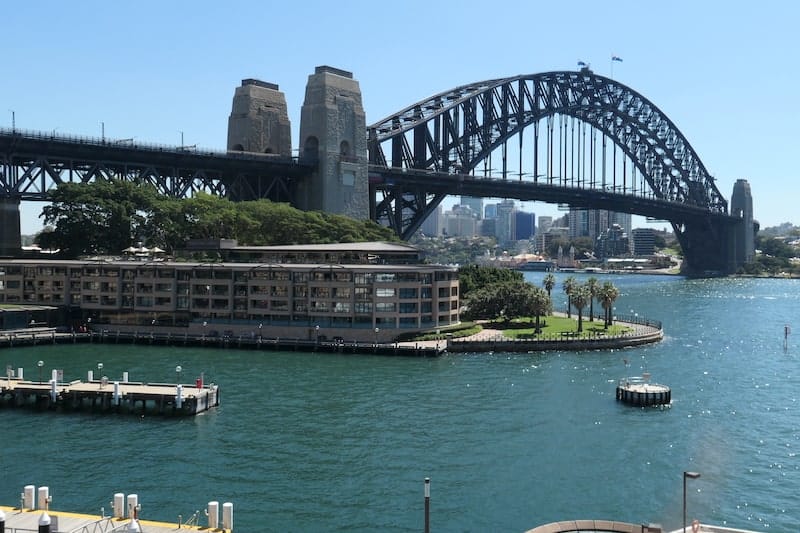
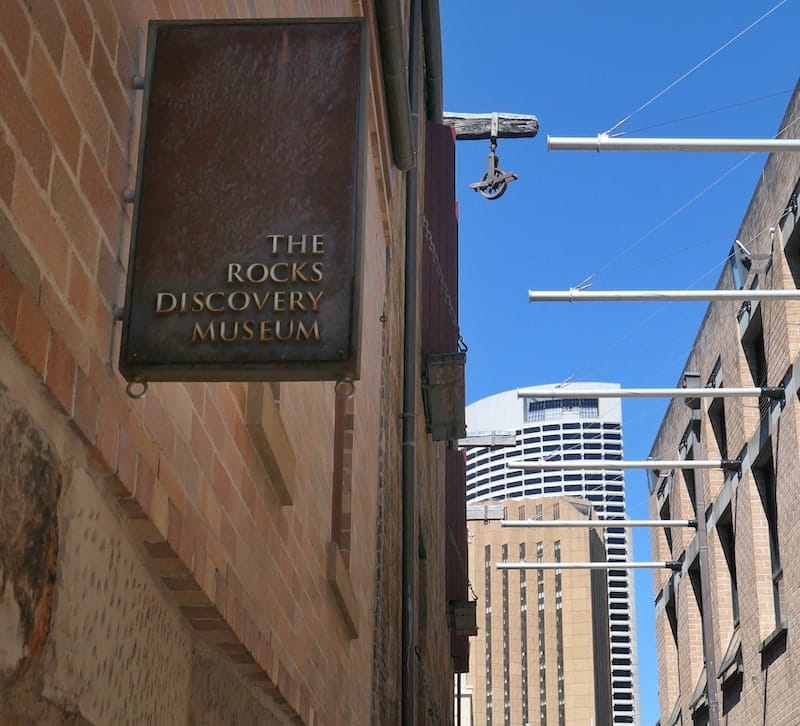







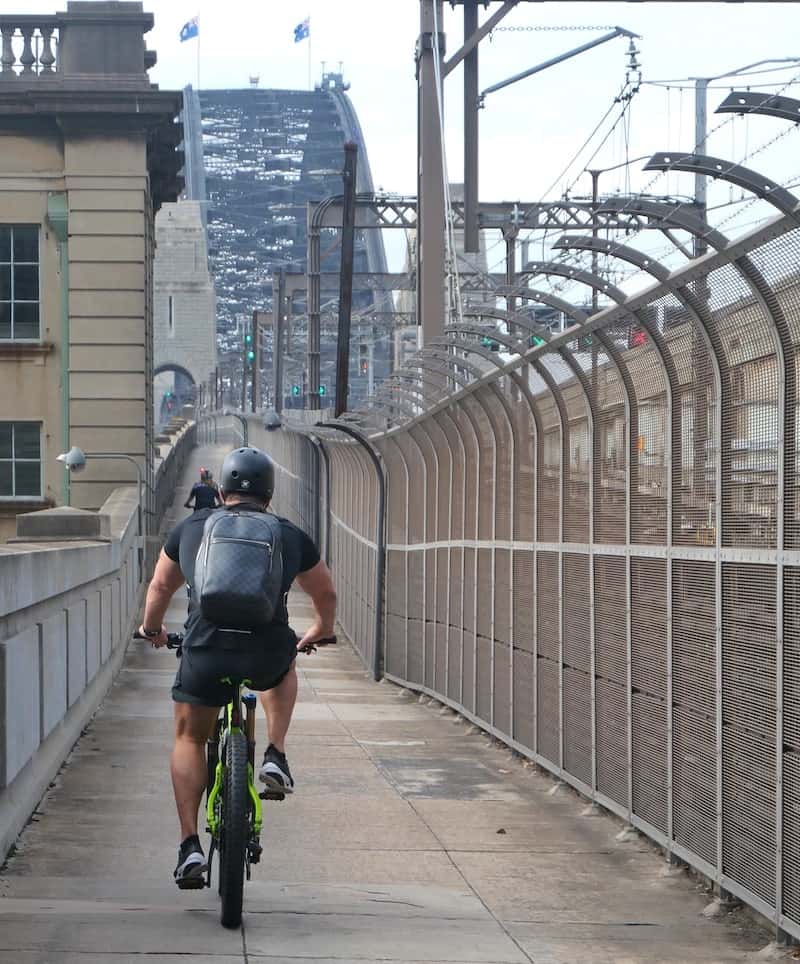
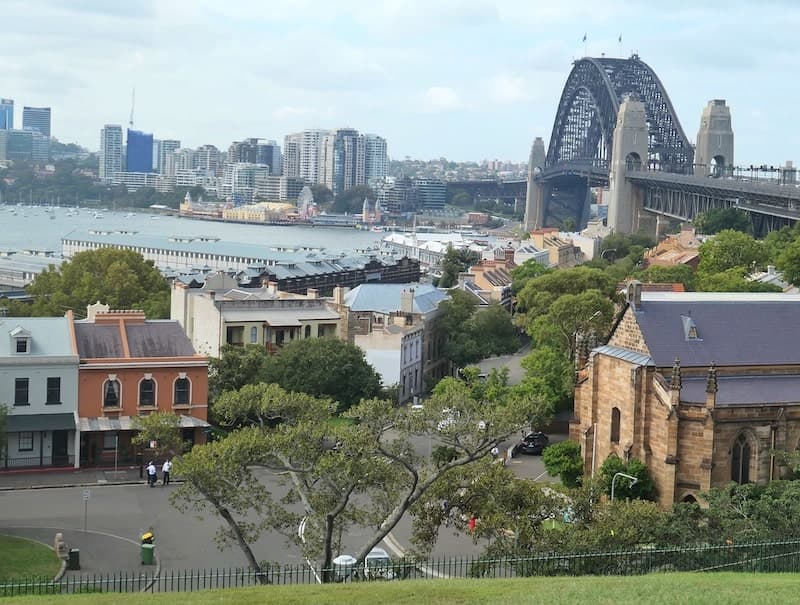





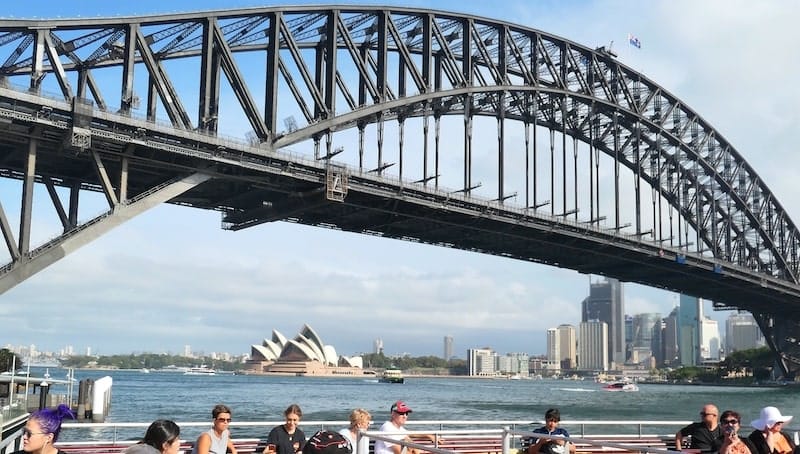








Hello Anne, thanks for the very detailed guide! I wish I had read it sooner when visiting Sydney, it would have saved me a lot of time doing research 🙂 Definitely a wonderful guide for first-timers in this great city. I didn’t know about the Suez canal, pretty funny one!
Kevmrc recently posted…20 Famous Landmarks in Sydney Australia (100% worth a visit)